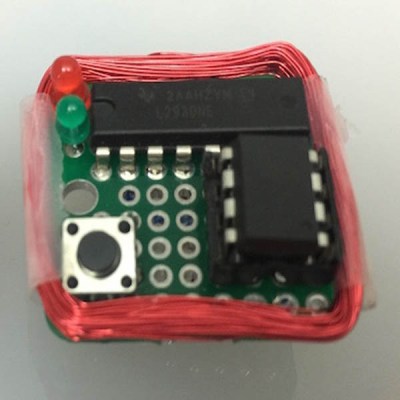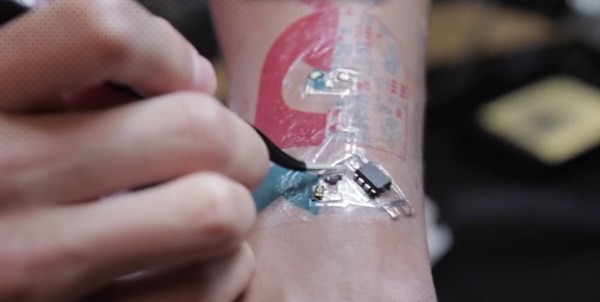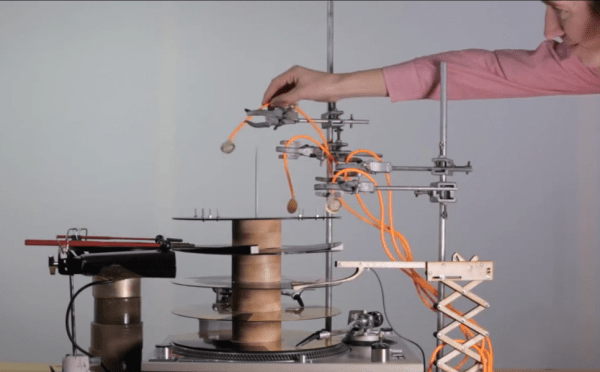Rumors about a new Raspberry Pi have been circulating around the Internet for the past week or so. Speculation has ranged from an upgraded Model A or compute module to a monster board with Gigabit Ethernet, USB 3.0, SATA and a CPU that isn’t even in production yet. The time is now, and the real news is even more interesting: it’s a $5 Raspberry Pi Zero. It’s the smallest Pi yet, while still keeping the core experience.
Day: November 25, 2015
Conductive Circuit Board Tattoos: Tech Tats
While hardcore body-hackers are starting to freak us out with embedded circuit boards under their skin, a new more realistic option is becoming available — temporary tech tattoos. They’re basically wearable circuit boards.
Produced by [Chaotic Moon], the team is excited to explore the future of skin-mounted components — connected with conductive ink in the form of a temporary tattoo. And if you’re still thinking why, consider this. If these tattoos can be used as temporary health sensors, packed with different biometric readings, the “tech tat” can be applied when it is needed, in order to monitor specific things.
In one of their test cases, they mount an ATiny85 connected to temperature sensors and an ambient light sensor on the skin. A simple device like this could be used to monitor someone’s vitals after surgery, or could even be used as a fitness tracker. Add a BLE chip, and you’ve got wireless data transfer to your phone or tablet for further data processing.
Continue reading “Conductive Circuit Board Tattoos: Tech Tats”
Hardware Hacker’s Black Friday / Cyber Monday Guide
Between Black Friday, Cyber Monday, and, apparently for some just because it’s a long holiday weekend, hacker-licious sales abound right now. Here’s a run-down gathered from our intrepid Hackaday team who spared little effort in gathering this information. After all, being the hub of hackerdom, everyone just tells us this stuff. Be sure to check the actual details on the site because after reading about all these awesome opportunities to stock up for winter projects, our head is spinning. What to buy? What to give?
Continue reading “Hardware Hacker’s Black Friday / Cyber Monday Guide”
Turntable Sequencer Keeps The Techno Beat
We’ve got to admit, we don’t have any idea what to call this hack. Artist [Graham Dunning] refers to it somewhat dryly as the “Mechanical Techno method”, but that doesn’t quite do it justice. We’re thinking “Turntable-sequencer-synthesizer-beat-box-dub-stepper thingy. With cowbell.”
Call it what you will, but [Graham] has really gone the distance in extracting as much sound as possible from the humble turntable, which is used as more of a synchronizer than a sound source. Although it does play records too – at least part of them; [Graham] masks the grooves and anchors the tone arm so that only part of a track is played. Other records are masked with conductive film over which wiper contacts are placed, providing triggers for various synthesizers. Particularly clever is the mechanical percussion section; a record is cut radially to form cams that mechanical followers trip over periodically to hit either the cone of a woofer for bass notes, or a cowbell for – well, cowbell.
It may not appeal to everyone, but you’ve got to admit there’s something mesmerizing about watching this rig in action. The beat is pretty catchy, and as you can see in the live performance video after the break, there’s a lot of room for [Graham] to express himself with this instrument. We wouldn’t mind seeing how Compressorhead would put this rig to work in their performances either.
Continue reading “Turntable Sequencer Keeps The Techno Beat”
Defeating Chip And PIN With Bits Of Wire
One of many ways that Americans are ridiculed by the rest of the world is that they don’t have chip and PIN on their credit cards yet; US credit card companies have been slow to bring this technology to millions of POS terminals across the country. Making the transition isn’t easy because until the transition is complete, the machines have to accept both magnetic stripes and chip and PIN.
This device can disable chip and PIN, wirelessly, by forcing the downgrade to magstripe. [Samy Kamkar] created the MagSpoof to explore the binary patterns on the magnetic stripe of his AmEx card, and in the process also created a device that works with drivers licenses, hotel room keys, and parking meters.
 The electronics for the MagSpoof are incredibly simple. Of course a small microcontroller is necessary for this build, and for the MagSpoof, [Samy] used the ATtiny85 for the ‘larger’ version (still less than an inch square). A smaller, credit card-sized version used an ATtiny10. The rest of the schematic is just an H-bridge and a coil of magnet wire – easy enough for anyone with a soldering iron to put together on some perfboard.
The electronics for the MagSpoof are incredibly simple. Of course a small microcontroller is necessary for this build, and for the MagSpoof, [Samy] used the ATtiny85 for the ‘larger’ version (still less than an inch square). A smaller, credit card-sized version used an ATtiny10. The rest of the schematic is just an H-bridge and a coil of magnet wire – easy enough for anyone with a soldering iron to put together on some perfboard.
By pulsing the H-bridge and energizing the coil of wire, the MagSpoof emulates the swipe of a credit card – it’s all just magnetic fields reversing direction in a very particular pattern. Since the magnetic pattern on any credit card can be easily read, and [Samy] demonstrates that this is possible with some rust and the naked eye anyway, it’s a simple matter to clone a card by building some electronics.
[Samy] didn’t stop there, though. By turning off the bits that state that the card has a chip onboard, his device can bypass the chip and PIN protection. If you’re very careful with a magnetized needle, you could disable the chip and PIN protection on any credit card. [Samy]’s device doesn’t need that degree of dexterity – he can just flip a bit in the firmware for the MagSpoof. It’s all brilliant work, and although the code for the chip and PIN defeat isn’t included in the repo, the documents that show how that can be done exist.
[Samy]’s implementation is very neat, but it stands on the shoulders of giants. In particular, we’ve covered similar devices before (here and here, for instance) and everything that you’ll need for this hack except for the chip-and-PIN-downgrade attack are covered in [Count Zero]’s classic 1992 “A Day in the Life of a Flux Reversal“.
Thanks [toru] for sending this one in. [Samy]’s video is available below.
A 3D Printed Car Jack? No, Seriously!
Ah nuts, I lost my car jack again. What will I do? Well, why not 3D print a new one?
Uploaded to Thingiverse earlier this week, this design allows you to 3D print a fully functional car jack — provided your build platform is large enough. It’s actually a bit of a promo for the Cheetah 2, a massive modular 3D printer by [Hans Fouche]. Earlier this year we shared his 3D printed lawn mower; which spoiler, also works.
The neat thing about the Cheetah 2 is that it doesn’t use filament. It actually processes plastic pellets right inside the hot end, allowing for much cheaper material — typically dollars on the kilogram, as opposed to the $30+/kg we’re all used to being gouged on. Of course, you could also make your own filament. Continue reading “A 3D Printed Car Jack? No, Seriously!”
APRS Repeaters Get The Signal Out Of Mammoth Cave
APRS Cave-Link uses the amateur radio’s Automatic Packet Reporting System (APRS) inside caves to get their position data (and other messages) out.
Imagine that you’re coordinating a large scale search-and-rescue mission in a cave. You need to know where all your groups are, and whether or not they’ve found anything. But how do they all communicate to the command center?
You’d guess radio, but you’d guess wrong. Radio doesn’t propagate well at all in a maze of twisty passages, all alike; rocks absorb radio waves, especially in the VHF/UHF range that’s best suited for most small radios. In the past, you’d run wire and transmit along it. This article runs through the options in detail. But adding miles of wire to your already heavy caving and climbing gear is a nuisance or worse.
Continue reading “APRS Repeaters Get The Signal Out Of Mammoth Cave”


















